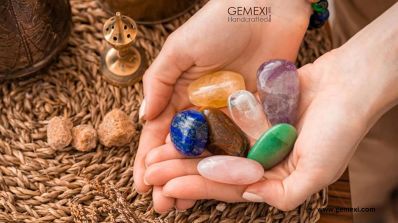Difference Between Faceted & Cabochon Gemstone
By Gemexi Team | Gemstone Healing- Updated On Jul 26, 2021

When it comes to popular types of gemstone cutting, faceted and cabochon cuttings deserve to be on the list. However, when it comes to opting for a gemstone, it is significant to know the differences between them. It is time to discuss the same.
About Faceted Gemstone
Did you know what the facets and pointed bottom of a gemstone are? The answer is the uniform, polished faces of the gemstone. A faceted gemstone can reflect light outside and refract light inside itself. Moreover, such a gemstone often comes as a transparent gemstone. For example, most diamond engagement rings come with faceted stones.A faceted gemstone comes with a flat top and facets all around it along with a sharp bottom. You already know how a faceted gemstone can reflect and refract light. This property enhances the brilliance and magnificence of the gemstone. Gemstones, which come transparent, often experience the faceted cutting so that their magnificence can be escalated.
More about Faceted Gemstone
Faceted gemstones can be of various shapes. For instance, when it comes to making jewelry with faceted gemstones, it can be of various shapes, such as ovals, stars, hearts, squares, and so on. Besides, faceted gems are also available in different sizes. As a result, various options in jewelry get available from which you can choose your favorite ones.When it is about using faceted gemstones for making jewelry, various settings are available for beginners, such as back-set settings, snaptite settings, wraptite settings, and pre-notched settings.
About Cabochon Gemstone
Some important facts you need to know about the same are mentioned below:- Cabochon gemstones come with a flat bottom as well as a hemisphere-shaped top. Moreover, such gemstones often feature natural markings and additions.
- Cabochon gemstones are often opaque whereas you already know faceted gemstones are transparent. When it comes to making jewelry with cabochon gemstones, a bezel setting is often evident. However, such gemstones are also fixed with glue.
- When it comes to choosing the gemstone’s cutting, it largely depends on the hardness of the gemstone. For example, cabochon cutting is often used for softer gemstones, which are more susceptible to form scratches. Hence, it can be concluded that comparatively harder gemstones go through the faceted process.
- Cabochon gemstones come with markings as well as natural inclusions. However, it is not seen with faceted cutting, as it interrupts the light, which can lower the magnificence of the gemstone.
- Cabochons are also available in various shapes as well as sizes like faceted. As a result, various jewelry designs have become available in the market. When it comes to shapes, cabochons are available in hearts, hexagons, ovals, squares, round, etc.
- When it is about making jewelry with cabochons, beginners can make use of various settings, such as ring settings, pendant settings, and earring settings. Although different settings are different, each of them often calls for the use of glue to set the cabochon. However, a pusher or bezel rocker is also used to fix the stone.
Benefits of Faceted Gemstones
- Faceted cutting escalates the magnificence and beauty of gemstones. It is because facets contribute to multiple angles, which can create a brilliant reflecting effect.
- Faceted cutting incorporates depth and enhances the appearance of the gemstone. Even top-notch faceting can help to conceal unwanted segments of a gemstone to ensure the beauty intact. Moreover, this cutting type brings a trendy and fashionable appearance to the gemstone. Different styles are possible with faceted cutting.
- Which gemstones often go through faceted cutting? The answer is sapphire, tourmaline, aquamarine, topaz, tanzanite, emerald, ruby, diamond, and morganite.
Benefits of Cabochon Gemstones
- Cabochon cutting is budget-friendlier than faceted cutting. It can escalate the appearance and color of the gemstone. Moreover, cabochon can highlight the optical effects of the gemstone.
- Cabochon is an ideal cutting method for comparatively softer gemstones, which are susceptible to scratches or fractures if go for faceted cutting.
- Which gemstones mostly go through cabochon cutting? The answer is aventurine, star sapphire, moonstone, turquoise, garnet, amber, opal, star ruby, and so on.
Which Gemstone Cutting Technique is better - Faceted or Cabochon?
It can’t be determined which technique is better than the other, as the technique chosen depends on the optical features as well as the quality of gemstones.However, more people nowadays are inclined towards faceted cutting, as it can make gemstones to be able to reflect light beautifully. Moreover, this technique also helps to enhance the sparkle of the gemstone.










1 Comments
Write CommentsThe difference between faceted and cabochon gemstones is very tough to identify. A faceted gemstone comes with a flat top and facets all around it along with a sharp bottom.